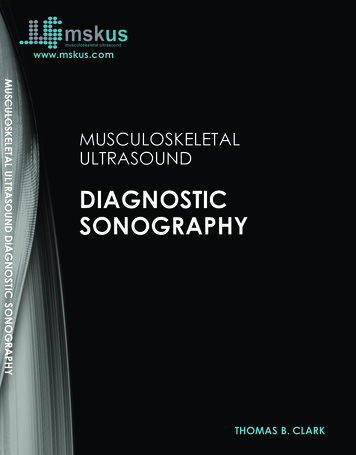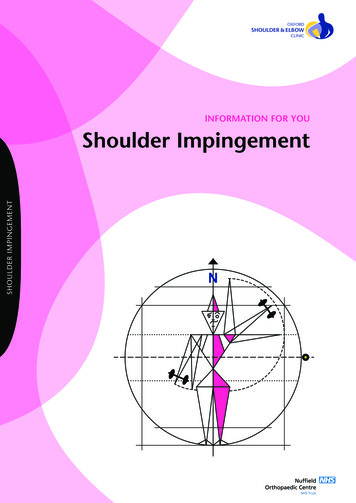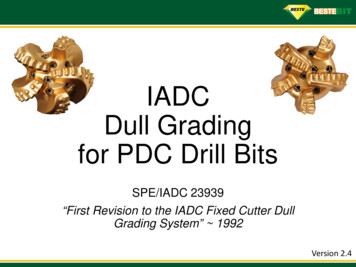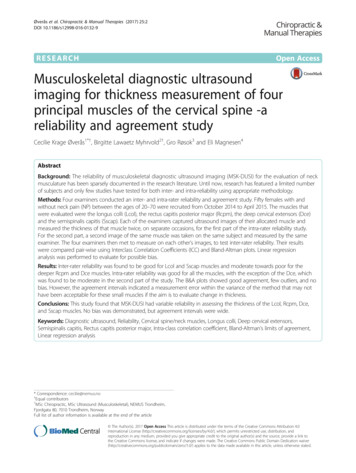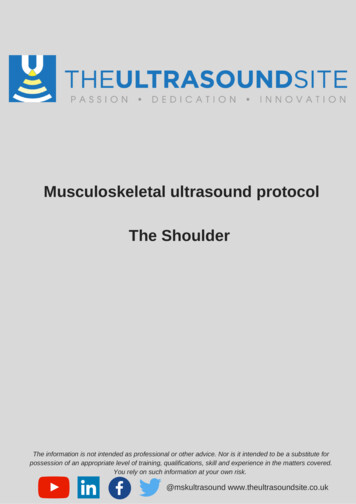
Transcription
Musculoskeletal ultrasound protocolThe ShoulderThe information is not intended as professional or other advice. Nor is it intended to be a substitute forpossession of an appropriate level of training, qualifications, skill and experience in the matters covered.You rely on such information at your own risk.@mskultrasound www.theultrasoundsite.co.uk
The Shoulder - Stage 1Long head of bicepstendon*FigureFigure 1:1: TransverseShort axis tendontendon*Figure 2: Long axis view of the long head of biceps tendonPlace the ultrasound probe on the front of the shoulder in a transverse plane, and youwill visualise the distinct bony outline of the bicipital groove and view the brighthyperechoic biceps tendon sitting within it (*,Figure 1). Consider the anatomy of the longhead of biceps and the bony contour of the humeral head and angle your probe in aslightly cephlad direction to ensure you can clearly see the long head of biceps tendon.Move the probe proximally and distally following the biceps tendon to themusculotendinous junction and proximal to the groove.Ensure you also visualise in long axis as well (Figure 2) and interrogate the tendon fromits proximal origin to its distal insertion.@mskultrasound www.theultrasoundsite.co.uk
The Shoulder - Stage 2Subscapularis tendon*FigureLongofaxisof the SubscapularistendonFigure 3: Longaxis3:viewthe viewSubscapualristendonSubscap*Figure4: viewShortofaxisof the SubscapularistendonFigure 4: Shortaxisthe viewSubscapualristendonThe patient is in sitting with the shoulder externally rotated. The ultrasound probe movesfrom the bicipital groove medially over the lesser tuberosity. This is the insertion of thesubscapularis tendon. Appreciate the fibres inserting onto the lesser tuberosity (*)towards the edge of the bicipital groove.In short axis, the tendon bundles are clearly visible(*). The areas in between the bundlesshow as hypoechoic fissures which gives the impression of tiger striping. Appreciate thatthis is a wide tendon (approximately 2 cm) . Make sure to scan the entire with of it.@mskultrasound www.theultrasoundsite.co.uk
The Shoulder - Stage 3Supraspinatus tendon*LHBLHBFigure 5: Short axis view of the Sipraspinatus tendontendonSubscap*Figure 6: Long axis view of the Sipraspinatus tendonIn short axis, starting from the bicipital groove the probe moves laterally over the greatertuberosity making sure that the long head of biceps can still be seen in the corner of the image(Figure 5). The probe now moves upward over the greater tuberosity and the Supraspinatusshould appear in its short axis appearance (*). The greater tuberosity should now be seen as asymmetrical spherical shape and the overlying supraspinatus tendon is of equal thicknessthroughout.In a longitudinal view (Figure 6), distally the bone contour should show a steep slope (*),likened to a parott beak. Here you should be able to see the tendon fibres insert on thegreater tuberosity. Move through the tendon, visualising the anterior, middle and posteriorfibres.@mskultrasound www.theultrasoundsite.co.uk
The Shoulder - Stage 3Supraspinatus tendon'Technique tips'SubscapThe illustration above serves as a reminder to ensure you are always absolutelyperpendicular to the tendon whilst visualising it in a transverse view. The greater tuberosityshould appear as a smooth rounded hyperechoic dome, and the Supraspinatus tendonsuperficial to this should be equal across the greater tuberosity. as in Figure 5, in Stage 3. Ifthe probe is oblique to the tendon, then the depth will vary, highlighting that the probe isoblique.@mskultrasound www.theultrasoundsite.co.uk
The Shoulder - Stage 3Supraspinatus tendon'Technique tips'SubscapThe subscapularis is well seen when moving medial from the biceps tendon location in thebicipital groove. Immediately medial is the lesser tuberosity with its insertion of the subscapularistendon.Thecrossectionalshows the tendonbundlesof the subscapulariswell. Itimportantalso helps one toWhenvisualising viewthe Supraspinatustendonin a longitudinalview, the sameappreciatethe widthof the subscapularistendonwhich Ifisthe2 cmor so.sppreciationrule of stayingperpendicularto the structureapplies.probeis Thisobliquethen the will alsoremindyou tothe entirewidth ofwillthenottendon.footprint at theinsertionto scanthe greatertuberositybe correct@mskultrasound www.theultrasoundsite.co.uk
The Shoulder - Stage 4Infraspinatus tendon*Figure 7: Long axis view of the Infraspinatus tendon*SubscapFigure 8: Long axis view of the Infraspinatus tendonWhen visualising the Infraspinatus tendon, place you probe on the posterior aspect ofthe joint and initially try to visualise the smooth outline of the humeral head. You willthen see the bright, thick and hyperechoic tendon of Infraspinatus (* in Figure 8)attaching onto the greater tuberosity (* in Figure 7)@mskultrasound www.theultrasoundsite.co.uk
The Shoulder - Stage 5Glenohumeral joint*SubscapFigure 9: Long axis view of the posterior aspect ofthe humeral head.Placing the probe on the back of the shoulder visualise the bright cortical outline ofthe posterior aspect of the humeral head (*). Interrogate the posterior labrum and therecess of the glenohumeral joint for effusion. You may need to 'toe in' the probe tovisualise this region clearly and also optimise your depth, frequency and focal zone.@mskultrasound www.theultrasoundsite.co.uk
The Shoulder - Stage 6Acromioclavicular joint*ACJSubscapPlacing the probe on the top of the shoulder joint, highlight the acromion process and move theprobe medially until you visualise the distinct appearance of the aromioclavicular joint (*).@mskultrasound www.theultrasoundsite.co.uk
Musculoskeletal ultrasound protocol The Shoulder @mskult rasound www. t heult rasoundsit e. co. uk The information is not intended as professional or other advice. Nor is it intended to be a substitute for possession of an appropriate level of training, qua






